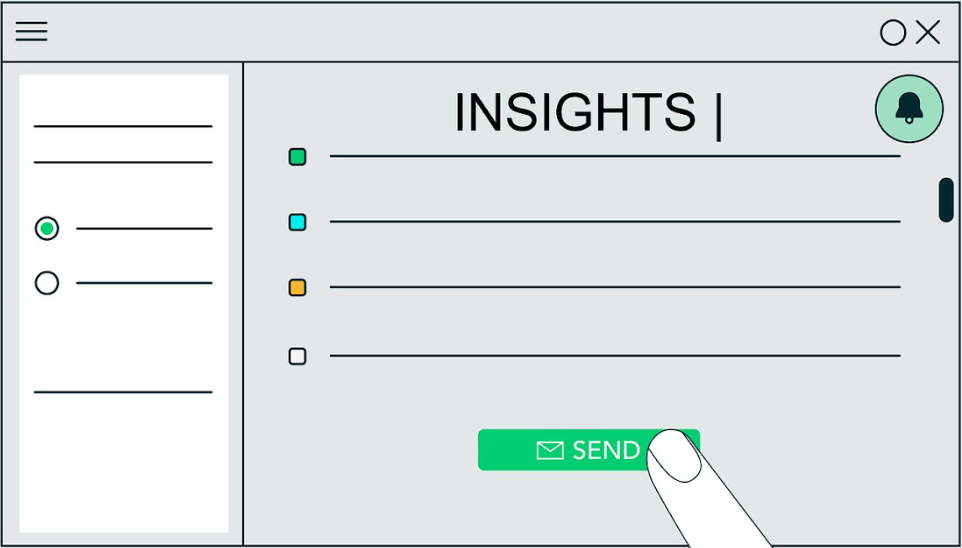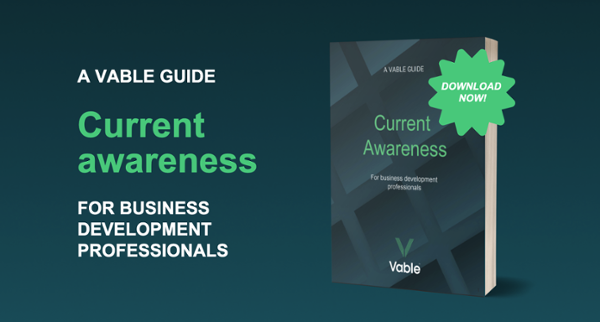Share this
How does Vable help legal BD teams deliver meaningful content to clients?
April 17, 2023

Your clients need and value your firm's professional expertise. They are looking to their trusted legal advisors to cut out the noise and reduce information overload. One of the roles of the business development and legal marketing team is to take a strategic approach and deliver only the content that matters to your clients.
An effective content marketing strategy ensures you can demonstrate legal expertise and create awareness for your legal services. But it is so much more than that. The 4 questions that follow aim to explain some important concepts and get you thinking about how premium content aggregator Vable makes it easier for you to engage with your clients through carefully selected content.
So what is the difference between content marketing and content curation?
First, we need some definitions to ensure we are all on the same page. According to the Content Marketing Institute, "content marketing is a strategic marketing approach focused on creating and distributing valuable, relevant, and consistent content to attract and retain a clearly defined audience — and, ultimately, to drive profitable customer action".
Content curation is the process of finding and collecting online content and presenting items that resonate best with your audience. Unlike content marketing, curation doesn’t necessarily involve creating your own content. After all, everyone enjoys reading and responding to quality content, whether it is third-party or proprietary information.
Vable gives you options to make the most of your content strategy. We provide innovative technology to deliver handpicked content to the people you do business with - generating trust and discussion by informing them about the news that matters to them.
How does content aggregation impact content curation?
Vable is a premium content aggregator, meaning all the information you need is brought together in one place. For instance, subscription or free quality news feeds, blogs, press releases, financial information and social media etc. Don’t forget to include your own internally created content. The information is processed by the aggregation software so that you can run targeted searches against the content.
Aggregation is the first step in your knowledge-sharing process.
The next step is content curation. This is when aggregated information is selected and annotated by people who understand those to whom the information is going. It's a careful thought process and forms part of the broader business development communications strategy. Obviously, curated material will vary in type and tone depending on where and how it will be disseminated.
The difference between these terms - aggregation and curation - is important. It differentiates the work of the knowledge and information services from that of the business development departments. Working collaboratively across departments in the firm is essential and ensures a client-focused outcome.
When was the last time you reviewed how you delivered content to clients?
Client newsletters are nothing new. For many years, lawyers and law firms have relied on updates and newsletters to maintain and build relations with clients. However, when was the last time you reviewed your content workflow? It can be a time-consuming and heavily manual process. After all that work, are your newsletters bringing real value to your readers?
In a recent interview about content and its importance in effective professional services marketing, they opened by stating that,
“The world has experienced an accelerated shift to digital and this has presented new opportunities for professional service marketers. Consequently, the way content is consumed has also changed and clients increasingly expect more personalised up-to-the-moment content that is delivered when they need it.”
Legal business development professionals have a wealth of technology at their fingertips to select, comment on, and deliver content that matters.
What are the benefits of curated content?
Content matters because it enables you to:
- Demonstrate your firm’s expertise - content should not only highlight the contributor’s expertise in a particular area but also clearly explain how and why certain developments (etc) will impact the client’s business.
- Build authentic relationships - if you consistently demonstrate your expertise, people will want to maintain a relationship with you and your firm. It also offers opportunities to continue conversations if you have a relevant article/podcast/video to share and discuss with your clients
What are the benefits of a content aggregation platform?
Aggregation, curation and delivery matter because they enable you to:
- Save time with automated workflows - putting together content takes time so if you can automate some of the processes, your team can focus on what is important. Automatically aggregate your favourite sources, curate and edit the content, and then send out newsletters - all from the same platform.
- Generate reports to identify where you’re adding value - data is everything. You cannot make data-driven decisions if you don’t have access to data! You want to demonstrate that your content strategy is having an impact. Analytics and reporting will show whether you are reaching and engaging with the right audience.
How does your client benefit from receiving curated content?
Your clients are awash with emailed newsletters so you have to stand out from your competitors. What else can you offer? It’s clear that with so much white noise, content marketing needs to be approached strategically in order for the right information to get through to the right people.
You need to ensure the following:
- Get to the point - they want to digest the information you send as efficiently as possible. Save them time with relevant, trustworthy and actionable content and they will keep coming back for more.
- Do they want emails - get creative with content delivery. Ask whether they want an alternative delivery method, for example, dashboards, RSS feeds, or intranet delivery?
- Are you listening? - are there better ways of fostering collaboration? Ultimately you want to add value to the client experience and give them exactly what they need.
And finally, some thoughts about dashboard delivery of curated content
Presenting information on a dashboard is a win for everyone. Dashboards or any type of shared end-user portal could be an interesting move for business development professionals. Shared dashboards make it easier for entire teams to be ‘on the same page’:
- It's a place for you to see and manage all your content
- It’s a place for your legal professionals to see their information feeds
- It’s a place for your clients to receive a selection of curated - or general - information feeds.
After all, if it matters to your firm, it matters to your clients. It could be a game changer in the way information is delivered to them. Corporates, pharmaceuticals, financial houses, in-house legal teams, barristers etc., could have access to their own dashboards, with expert searching and curation provided by the law firm.
Dashboards remove the need for emailed newsletters unless clients specifically request bespoke roundups. Unlike scheduled alerts, dashboards can provide them with an at-a-glance view of their feeds on their desktop or mobile.
Vable understands that legal business development professionals want to build authentic and meaningful client relations. We enable you to do this by providing the tech to deliver handpicked content to the people with whom you do business - your curatorial expertise and invaluable analysis will make all the difference.
Share this
- December 2025 (2)
- November 2025 (2)
- October 2025 (3)
- September 2025 (2)
- August 2025 (2)
- July 2025 (4)
- June 2025 (3)
- May 2025 (2)
- April 2025 (1)
- March 2025 (1)
- October 2024 (1)
- July 2024 (1)
- June 2024 (2)
- May 2024 (2)
- April 2024 (3)
- March 2024 (3)
- February 2024 (4)
- January 2024 (2)
- December 2023 (1)
- November 2023 (2)
- October 2023 (2)
- September 2023 (1)
- August 2023 (3)
- July 2023 (5)
- June 2023 (2)
- May 2023 (2)
- April 2023 (4)
- March 2023 (1)
- February 2023 (1)
- January 2023 (2)
- November 2022 (2)
- September 2022 (2)
- August 2022 (2)
- July 2022 (1)
- June 2022 (1)
- May 2022 (2)
- April 2022 (3)
- March 2022 (1)
- February 2022 (2)
- December 2021 (2)
- November 2021 (2)
- October 2021 (2)
- September 2021 (2)
- August 2021 (2)
- July 2021 (2)
- June 2021 (2)
- May 2021 (1)
- April 2021 (2)
- March 2021 (1)
- February 2021 (3)
- January 2021 (2)
- November 2020 (3)
- October 2020 (1)
- August 2020 (2)
- July 2020 (4)
- June 2020 (1)
- May 2020 (1)
- April 2020 (2)
- March 2020 (2)
- February 2020 (3)
- January 2020 (1)
- December 2019 (2)
- November 2019 (1)
- October 2019 (1)
- September 2019 (1)
- August 2019 (3)
- July 2019 (3)
- June 2019 (3)
- May 2019 (2)
- April 2019 (1)
- March 2019 (2)
- February 2019 (3)
- January 2019 (3)
- December 2018 (1)
- November 2018 (2)
- October 2018 (2)
- September 2018 (1)
- August 2018 (2)
- July 2018 (1)
- June 2018 (2)
- May 2018 (3)
- April 2018 (3)
- March 2018 (1)
- February 2018 (3)
- January 2018 (1)
- November 2017 (1)
- October 2017 (1)
- July 2017 (1)
- April 2017 (2)
- March 2017 (3)
- February 2017 (1)
- January 2017 (1)
- November 2016 (2)
- October 2016 (1)
- September 2016 (1)
- August 2016 (2)
- June 2016 (1)
- May 2016 (1)
- April 2016 (1)

